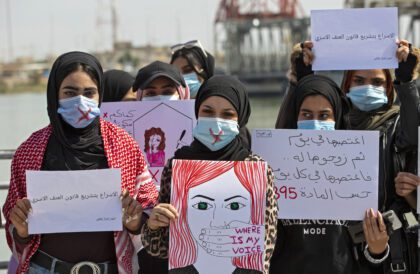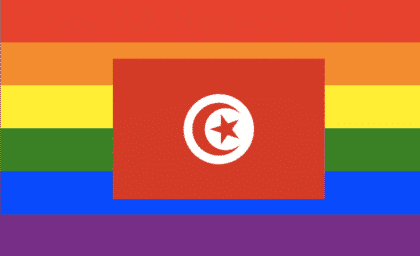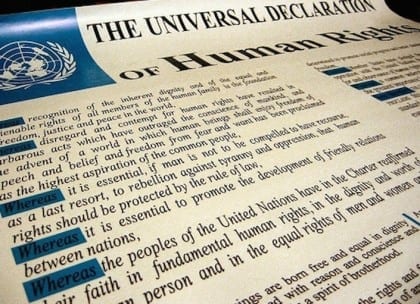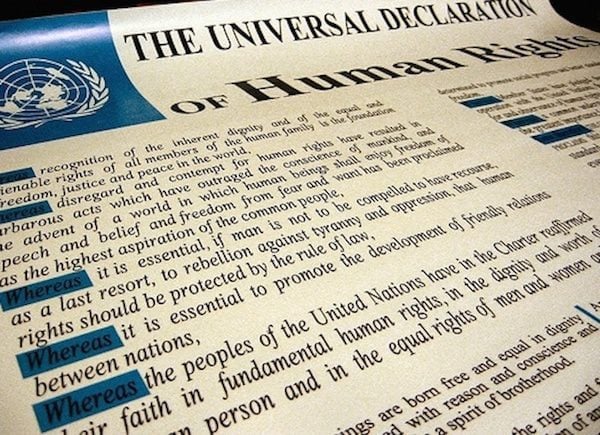
Introduction
The concept of human rights has become a well-known and widely accepted term to use. Varying interpretations are possible, with differences usually being based on cultural background. Nonetheless, most of these understandings consciously or subconsciously include the basic rights outlined in the United Nations’ Universal Declaration of Human Rights.
The United Nations General Assembly (GA) adopted the Universal Declaration of Human Rights on December 10th, 1948. It was written in the aftermath of World War II, “… as a common standard of achievement for all peoples and all nations, to the end that every individual and every organ of society, keeping this Declaration constantly in mind…” Thus, it was truly meant to be universal, to protect citizens from any violation the world had recently experienced, as outlined in the Preamble and 30 Articles.
As such, it includes articles on the right to life in dignity; liberty and security; freedom of movement; right to nationality and education; just treatment of human beings and respect; as well as freedom of expressions and opinions, from torture or inhumane treatment, as well as economic, social and cultural rights.
International Human Rights Law
The Declaration is not legally binding but is the basis of international human rights law. Two binding UN covenants were formed due to the UDHR; the International Covenant on Civil and Political Rights and the International Covenant on Economic, Social, and Cultural Rights. Combined, these three documents are often referred to as the “International Bill of Human Rights.”
Over the years, other conventions have been written to expand on and add to this fundament, focusing on a variety of topics such as refugees (1951 and 1967), discrimination of women (‘CEDAW,’ 1979) and disabled persons (2008), against torture (1987), protection of migrant workers (1990), and against racial discrimination (1969) to name a few.
Additionally, the International Labour Organization has compiled a large number of conventions specifically related to the workforce and labor standards, of which 8 are considered ‘fundamental conventions’ and relate to freedom of association (1948, C087), collective bargaining (1949, C098), forced labor (1930, C029 and 1957, C105), minimum age (1973, C138), child labor (1999, C182), equal remuneration (1951, C100), equal opportunity and treatment (C111).
Geneva Conventions
The Geneva Conventions are a revision of previously constructed conventions, adjusted after WWII, and specifically, focus on treating persons in times of war. It consists of four Conventions and three additional protocols. The International Committee of the Red Cross (ICRC) explains that the Conventions “aims at ensuring that, even in the midst of hostilities, the dignity of the human person, universally acknowledged in principle, shall be respected.”
During a series of expert meetings, congregations by Red Cross agencies, and a confluence of government representatives over time, the articles were revised until a draft was represented at The Diplomatic Conference for the Establishment of International Conventions the Protection of Victims of War in 1949. The Final Act was signed by fifty-nine nations, some of which no longer exist, and has attained more signatories.
The Cairo Declaration on Human Rights in Islam (CDHRI) was compiled by the Organisation of Islamic Cooperation (OIC) in 1990, during the 19th Islamic Conference of Foreign Ministers in Cairo, and has 57 signatories. This Declaration holds similar – if not identical – principles as the UDHR, but notably included articles related to ‘jus in bello’ – acceptable wartime conduct, similar to the Geneva Conventions. The CDHRI also addresses equality between women and men, rights of the child, freedom, right to medical care, right to self-determination. Most notably, this 25 Article document clearly lists the Sharia as a reference point, including punishment. The CDHRI has been adopted by 45 countries, out of the total 57 members of the OIC.
Conventions Signed By Tunisia
Tunisia signed the Conventions on 5 May 1957, Additional Protocol I (Protection of Victims of International Armed Conflicts) and Additional Protocol II (Protection of Victims of Non-International Armed Conflicts) on August 9, 1979. Moreover, Tunisia became a signatory to the Convention for the Rights of the Child (CRC) on 30 January 1992 and the Optional Protocol to the CRC on 2 January 2003.
Tunisia has been a member of the OIC since 1969 and ratified all eight fundamental ILO conventions.
Refugees
The Convention Relating to the Status of Refugees is based on Article 14 of the UDHR and recognizes refugees’ right to asylum and protection. It was approved during the General Assembly meeting of December 14, 1950, and came into force on April 22, 1954. However, the original Convention limited its scope to refugees fleeing before 1 January 1951. As such, an additional protocol was compiled in 1967, removing these limitations.
On October 24, 1957, it became the successor to the Convention and Protocol. Concerning multilateral treaties, succession means the State expressed its consent to be considered as bound thereby.
Women
The Convention on the Elimination of All Forms of Discrimination against Women – also called CEDAW, was approved during the General Assembly Session on 18 December 1979 and entered into force on 3 September 1981. Tunisia signed the Convention on 24 July 1980 and ratified it on September 20, 1985. Countries that have ratified or acceded to CEDAW are legally bound to put its provisions into practice and agree to submit national reports on measures taken to comply with its obligations. Such reports are to be compiled at least every four years.
Along with its ratification, Tunisia made apparent many reservations, stating provisions of Chapter I of the Tunisian Constitution trump the Convention in case of a conflict between them. Specific mention was made of Article 9 (2) concerning children’s nationality – not adhered to if it conflicts with Chapter VI of the Nationality Code.
Tunisia does not consider itself bound to Article 16, 1c, prescribing the same rights and responsibilities during marriage and upon dissolution; 1d, listing the same rights and responsibilities of parents regardless of their marital status; and 1f, granting equal rights and responsibilities regarding guardianship, wardship, trusteeship, and adoption; and holds reservations towards paragraphs 1g, prescribing equal personal rights, including that of choosing a family name and profession; and 1h, granting equal rights to spouses about property ownership – stating it must not conflict with provisions of the Personal Status Code.
Additionally, the country is not bound to Article 29 (1), discussing disputes between states concerning the Convention’s application’s interpretation. It is noteworthy that Article 29 (2) specifically allows for such a reservation.
Additionally, Tunisia declared Article 15, paragraph 4 – prescribing equality in freedom of movement and domicile – that it must not be interpreted in a conflicting manner to the Personal Status Code chapters 23 and 61.
Persons with Disabilities
The Convention on the Rights of Persons with Disabilities was approved during the General Assembly session on December 13, 2006, and came into force on May 3, 2008. Simultaneously, the Optional Protocol was approved, giving the Committee on the Rights of Persons with Disabilities (CRPD) competence to examine individual complaints about alleged violations by States parties to the Protocol. The CRPD is the body of independent experts that monitors the implementation of the Convention. Tunisia signed both the Convention and the Optional Protocol on March 30, 2007, and ratified both on April 2, 2008. No reservations were submitted.
Torture
The Convention against Torture and Other Cruel, Inhuman, or Degrading Treatment or Punishment, also referred to as just the Convention against Torture, was adopted during the General Assembly session on December 10, 1984. On June 26, 1987, it was registered and thereby came into force. Its implementation is monitored by the Committee Against Torture(CAT), composed of ten individuals of various nationalities. All signatory states are obliged to send regular reports to the CAT, based on which recommendations are made. Tunisia signed the Convention on August 26, 1987, and ratified it on September 23, 1988. Upon ratification, it completely withdrew the reservations made upon signing, which were related to Articles 21 and 22 listing the Committee’s competencies.
Migrant Workers
The International Convention on the Protection of the Rights of All Migrant Workers and Members of their Families was approved by the General Assembly on December 18, 1990, and entered into force on July 1, 2003. Tunisia is not a party to the Convention.
Racial Discrimination
The Convention on the Elimination of All Forms of Racial Discrimination was approved by the General Assembly and opened for signature on March 7, 1966. It entered into force on January 4, 1969. Despite the obvious, as stated in the Convention title, it aims to obliterate hate speech and promote understanding. Implementation of the articles is monitored by the Committee on the Elimination of Racial Discrimination, to which each signatory submits bi-annual reports. It is also responsible for handling inter-state and individual complaints related to non-conformity to the Convention’s provisions, as prescribed in Article 14.
Tunisia signed the Convention on April 12, 1966, and ratified it on January 13, 1967, with no reservations.
Human Rights in Tunisia
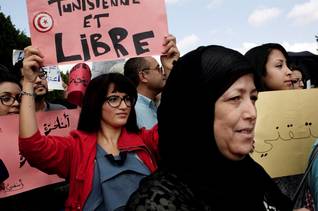
Since the Ben Ali regime’s overthrow, Tunisia has advanced human rights in several fields: a pluralistic election law was adopted, leading to relatively free and fair Constituent Assembly elections in October 2011. People are now allowed to establish political parties and stand for election, and peaceful demonstrations are permitted, although the police have responded to some with disproportional force.
Also, freedom of the media has been promoted, and, following the revolution, Tunisia has seen several new media outlets pop up, including English-language outlets. Yet, this initial freedom has recently been increasingly challenged, as attacks on journalists and media restrictions have increased.
Another major challenge to human rights remains the continuing need for an independent judiciary to guarantee fair trials and applying the law. In the past, the regime’s control of the judiciary was a major contributor to human rights violations.
A major disappointment for human-rights advocates is that Tunisia’s new Constitution will not include an explicit reference to international human rights laws and treaties. Instead, it refers to Tunisia’s ‘cultures and principles of human rights, a vague expression that leaves much room for interpretation.
Although it does not include explicit reference to the Sharia (Islamic law), the Constitution stresses the importance of Tunisia’s cultural heritage and its Islamic values, which has led some observers to conclude that this provision might lead to a de facto implementation of Islamic law. In fact, while the criminalization of blasphemy is not enshrined in the Constitution, blasphemy trials have increased recently – considered the most serious threat to freedom of expression.
The emphasis on Islamic values in the Constitution has also questioned the position of women in Tunisian society. An article referring to the ‘complementary’ rather than the ‘equality of gender relations’ might be included in the Constitution, in what many see as a direct threat to women’s rights.
Latest Articles
Below are the latest articles by acclaimed journalists and academics concerning the topic ‘Human Rights’ and ‘Tunisia’. These articles are posted in this country file or elsewhere on our website:







